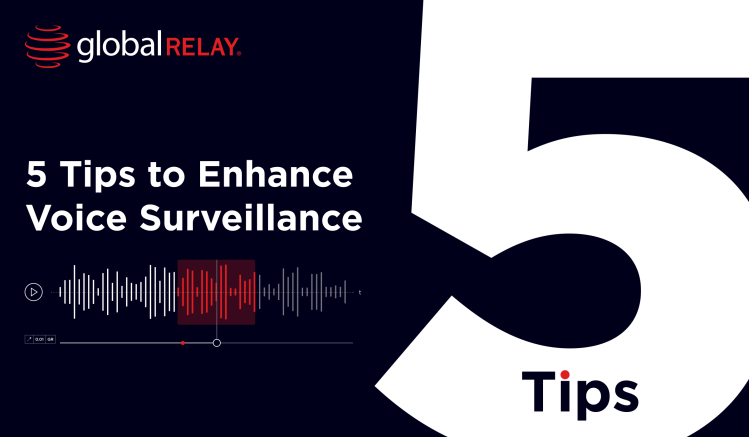With so many different forms of digital communication available, the idea of speaking to a contact over the phone might feel ‘old school’. However, in business verticals like financial services, voice conversations are still a vital part of day-to-day operations – and as such are increasingly subject to regulatory scrutiny.
While we’ve yet to witness regulators cracking down on voice communications with the same severity as we have other comms channels, there are still expectations that firms capture, retain, and surveil voice channels. The EU’s Markets in Financial Instruments Directive II (MiFID II) requires that firms retain records of voice calls related to trades, with the Financial Conduct Authority (FCA)’s Senior Management Arrangements, Systems and Controls (SYSC) section 10.A including a similar mandate.
While previous surveillance methods like ‘dip sampling’ recorded voice conversations may have sufficed in the past, firms are now required to capture and monitor voice communications at increasing scale, and to conduct similar monitoring of audio communications – such as key word analysis – in the same way they do digital channels. Firms looking to establish an effective voice capture, archiving, and surveillance strategy can benefit from these five tips.
1) Know which communications channels might have voice functionality
There are many channels where the need to capture voice will be obvious. Phone calls can be placed on ‘actual’ hardware like landline and mobile phones, but also via Voice Over Internet Protocol (VoIP) services that place calls over internet connections.
The rise of hybrid working has introduced a range of video meeting and collaboration platforms, with these video calls naturally including an audio component that should be captured. Familiar names include Zoom, Cisco Webex, and Microsoft Teams, and firms should ensure these channels are being considered when establishing a voice capture and surveillance program.
However, other channels present perhaps unexpected voice-communications based risk. Trading venues and turrets can include both messaging and voice chat functionalities to enable traders to make real-time decisions. Popular messaging and social media platforms like WhatsApp, X, Instagram, and LinkedIn all feature voice-note or messaging functionality, which potentially gives users looking to hide misconduct through off-channel communications another means of doing so – and compliance teams another challenge to tackle.
2) Comprehensively review your voice systems and workflows – and keep reviewing them
Knowing which channels are capable of voice communications is one thing, but knowing which channels your teams actually use to conduct voice communications is vital in building an effective capture and surveillance program.
While your teams might use Microsoft Teams for digital messaging and collaboration, they may use Zoom for calls with external clients, and Cisco for internal calls. Understanding where your teams are conducting voice communications means you aren’t investing resource into implementing solutions in the wrong areas, and will allow you to research comprehensive end-to-end solutions that can capture and archive data from all the relevant voice channels. This workflow audit will help to establish where potential gaps in your posture are, what solutions might be required to plug them, and where you might need to work with third-party partners to meet regulatory requirements.
The communications space is evolving fast, and voice communications are no exception. Performing a compliance and workflow review isn’t ‘one and done’ – new voice channels come into the market constantly, and existing communications channels are adding voice capabilities. Compliance teams need to make sure their strategies are consistently reviewed to ensure they’re functioning as intended and can be adapted as required to mitigate new risks or challenges.
3) Ensure recordings are automatically archived to meet recordkeeping requirements
Some voice and video communication applications will automatically save and store recordings on a user’s system in local files, or perhaps even on a shared cloud platform. However, this means that files are easily accessible for users, and can be subject to accidental loss, corruption, or even purposeful deletion should a user be trying to hide records of conversations. Voice files are often quite large compared to text files, and over-zealous system administrators looking to save space might look to delete them – without realizing the potential repercussions.
Where applications or workflows are not set up to automatically save recordings, such as traditional landline or mobile phones, firms run a real risk of conversations not being recorded at all, or data being lost or corrupted where teams attempt to move data to a separate archiving system.
By employing a solution that captures from source and automatically sends all recordings to a compliant archive, firms gain peace of mind knowing that their data will be captured and retained without needing to take additional steps, and risk of loss is eliminated. Regulators take an exceptionally dim view of firms being unable to provide data on request, and automatic archiving means that firms will never turn up empty handed should regulators come knocking.
Storing data in a centralized, compliant archive also means that firms keep all of their compliance data in one highly accessible location, making it easier to build cases or notice signs of potential misconduct by reviewing relevant data from different channels alongside one another, giving access to vital context and minimizing the potential time and resource needed to locate files.
4) High quality data, high quality outcomes
Capturing voice data to meet regulatory requirements is becoming a business essential, but ensuring that this data – and associated metadata – is high quality is also important. Conversation data that includes associated information like time and duration of call, sender, recipient, platform, and other details can help compliance teams to group voice conversations with conversations from other channels by particular uses who might present risk.
Better data quality also makes data more easily sortable and searchable at speed and at scale, which is especially vital when teams are against the clock to meet a regulatory or audit request. Capturing complete data and metadata also minimizes potential ‘gaps’ in explainability, and reduces the need for employees to manually review calls and recordings.
As compliance workflows continue to integrate AI and machine learning based elements, data quality becomes increasingly important. ‘Feeding’ these systems with high-quality data ensures they learn from the best data sets, reducing the chances of false positives or time-sapping manual reviews and data clean-up, and securing better and more efficient AI outcomes.
5) Go beyond voice files and leverage accurate transcription
Current ‘dip sampling’ practices where calls are selected at random to be reviewed are increasingly inadequate, and present a very real risk of signs of misconduct being missed. Even the largest firms do not have the resources to manually review the hundreds of hours of voice conversations that take place daily, and sifting through ‘business as usual’ conversations presents other reviewing challenges such as language barriers and trading jargon.
Accurate transcription of calls and voice files gives a full written record of conversations, with speaker separation and associated metadata generated automatically and stored in a compliant archive. From there, the transcription can be easily searched through and will fall under a firm’s wider compliance policies. So, for example, any potential warning signs of misconduct that would have taken many hours of manual listening and transcription can be identified and flagged automatically by compliance policies. Potential warning signs of misconduct that can be monitored for include:
- Signs of non-financial misconduct, such as racist, threatening, or derogatory language
- Indications of insider trading or market manipulation, even if keyword triggers are potentially obscured by trading slang or jargon
- Potential signs of off-channel communications, such as speakers being asked to “contact me on WhatsApp” or “let’s discuss offline”
By having access to accurately transcribed records of conversations, stored alongside the audio files, firms can more easily integrate voice channels into their existing compliance workflows and automatically flag potential risks for further review. Manual reviewers can then step in to listen to conversations with their context, tone, and sentiment intact and assess whether escalation is appropriate. Utilizing a solution that presents the audio waveform with flagged policy hits highlighted further streamlines the process – and means that reviewers can tune in and identify voice-based risk faster and more accurately than ever before.




